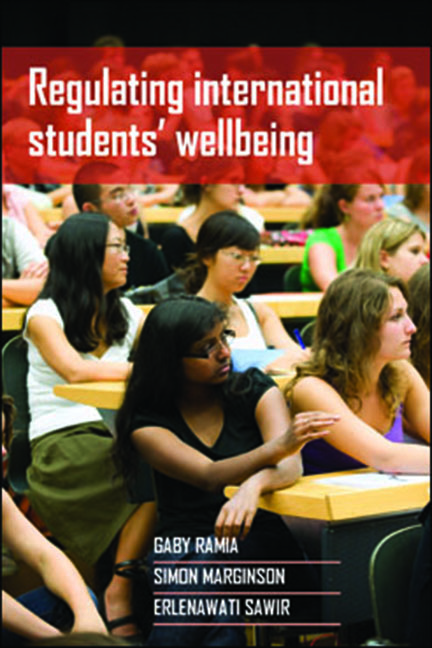Book contents
- Frontmatter
- Contents
- List of figures and tables
- Acknowledgements
- Preface
- one Introduction: global students and their discontents
- two Governing globalisation? National regulation and international student wellbeing
- three Fast growing, diverse: mapping the business of international education
- four ‘There’s gold in them thar students!’ Australia and New Zealand in the global market
- five Much regulation, minimal protection: the Australian model
- six Pastoral care, minimal information: the New Zealand model
- seven Different frameworks, similar outcomes: comparing Australia and New Zealand
- eight Doing it differently: national and global re-regulation and trans-national student citizens
- nine Conclusion
- References
- Index
one - Introduction: global students and their discontents
Published online by Cambridge University Press: 03 February 2022
- Frontmatter
- Contents
- List of figures and tables
- Acknowledgements
- Preface
- one Introduction: global students and their discontents
- two Governing globalisation? National regulation and international student wellbeing
- three Fast growing, diverse: mapping the business of international education
- four ‘There’s gold in them thar students!’ Australia and New Zealand in the global market
- five Much regulation, minimal protection: the Australian model
- six Pastoral care, minimal information: the New Zealand model
- seven Different frameworks, similar outcomes: comparing Australia and New Zealand
- eight Doing it differently: national and global re-regulation and trans-national student citizens
- nine Conclusion
- References
- Index
Summary
China goes to New Zealand: a morality tale
Each year a growing number of college and university students are travelling to foreign countries (nations other than the nation in which they hold citizenship rights) in order to study. Between 2000 and 2010 the worldwide number of foreign students increased from 2.1 million to 4.1 million, an expansion of 99 per cent in only a decade (OECD, 2011, p 364). Total student mobility is much greater, as it also includes students who travel for semester-length programmes or on short-term student exchanges. In short, international education is part of the biography of more and more people. It has become a key phase in life, the passport to a new environment and career, and even perhaps a new identity.
While the growth of international education has been rapid, the expansion has not been the same everywhere. Like most social trends it is subject to fits and starts and appears ‘lumpy’, accumulating in some places rather than others. Certain nations produce large numbers of students on the move, and certain nations specialise in educating them, while other nations remain relatively untouched. As we discuss in Chapter Four, in the early 2000s, among the world's fastest growing providers of international education were the Asia-Pacific nations Australia and New Zealand. Although New Zealand started a bit later than Australia, growth became even more rapid, largely fuelled by China, with New Zealand being marketed vigorously, for a time, by education agents in China. A growing number of Chinese families had the means to pay for foreign education, and an English language education offered definite advantages, especially to families working in the export businesses driving much of China's growth. New Zealand was seen as safe and clean, cheaper than the other English language countries, with a reputation for multicultural tolerance and strong educational institutions with roots in British schooling and universities.
At first the rapid growth in the number of Chinese students was trouble free. Chinese families were eager to take up the opportunity and the dollars flowed in. The export industry seemed to be a ‘winwin’ for everyone. But not everyone in New Zealand was comfortable with the influx of new faces, and a disquieting pattern of stereotyping and hostile media coverage developed (Collins, 2006).
- Type
- Chapter
- Information
- Regulating International Students’ Wellbeing , pp. 1 - 18Publisher: Bristol University PressPrint publication year: 2013



